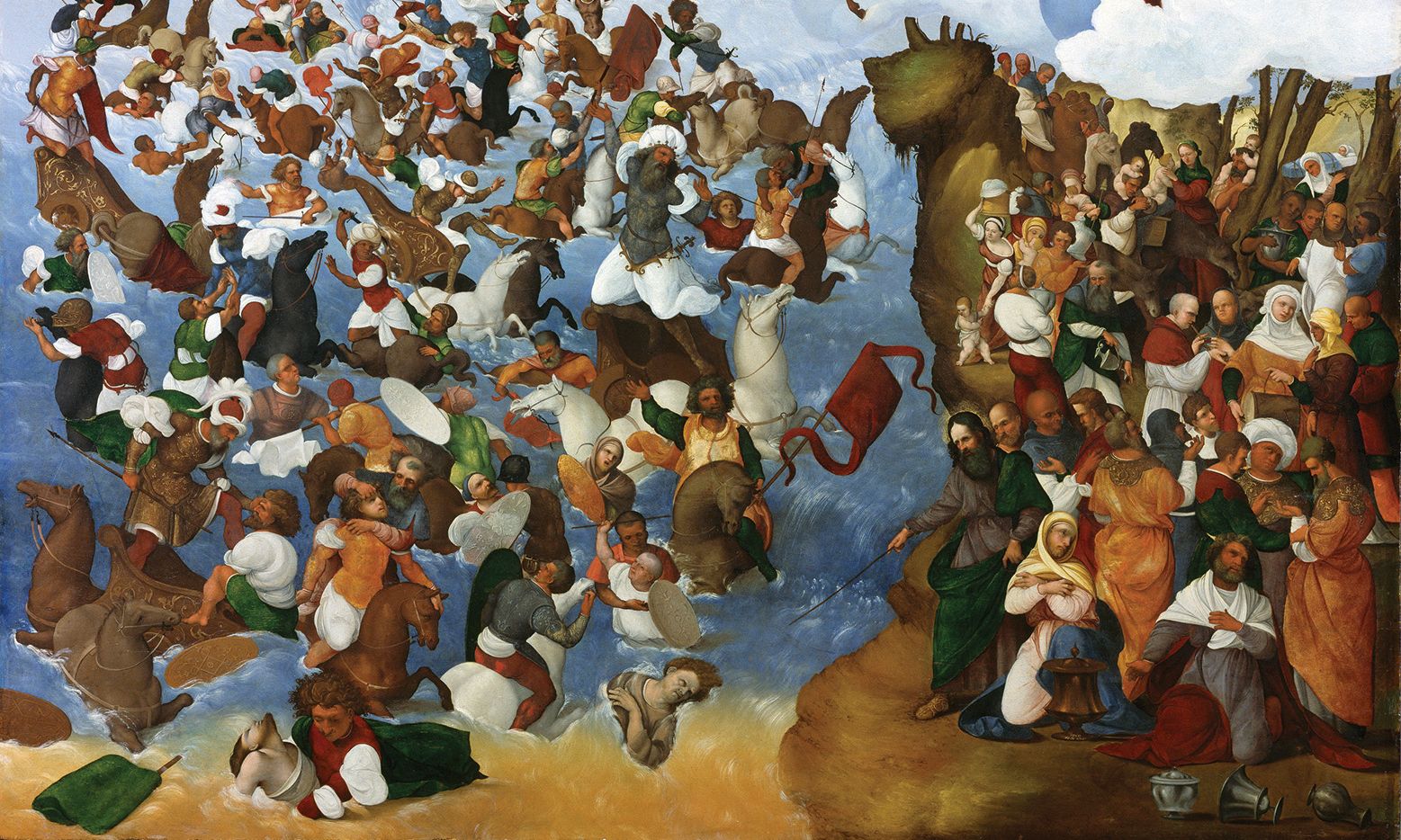A major research and conservation project has begun on Ludovico Mazzolino’s The Crossing of the Red Sea (1521), below. The restoration is backed by a grant from Tefaf
The Italian Renaissance painter Ludovico Mazzolino was known for small, jewel-like religious paintings; devotional objects for aristocratic patrons. Very occasionally towards the end of his career, presumably as special commissions for such patrons, he worked on a larger scale—and created conservation nightmares for centuries of owners. Just three such works are known to be in public collections—in Rome, Berlin and Dublin—and of these, only Christ Among the Doctors, at the Doria Pamphili in Rome, has been stable enough for display.
The National Gallery of Ireland has owned one of these rarities since 1914—The Crossing of the Red Sea (1521)—but it has never been on show. A major research and conservation project has now begun in the gallery’s laboratory, backed by a €25,000 grant from the European Fine Art Foundation (Tefaf), which should allow the work to be displayed for the first time and also solve some problems for other owners.
“It’s quite a famous painting, and we are often asked to loan it for exhibitions—but in its present condition, that’s just impossible. It can’t travel,” says Aoife Brady, the curator of Italian and Spanish art at the gallery. The grant has enabled Brady and the lead conservator on the project, Maria Canavan, to visit the other panels, envying the condition of the Rome painting and finding the Berlin work, in the depot of the state museums, in the same parlous state as their own.
Mazzolino’s interpretation of the Bible story of the Red Sea parting for the Israelites before the waters rush back to drown the Egyptian army is an extraordinary composition, heaving with detail in queasily shifting perspective. The blue waters seethe with men and horses while the Israelites on the bank give thanks for their safe crossing, God glares down from the clouds and an angel hurtles down on a flying horse. More than 130 figures have already been identified, and under the present paint surface lie more, later erased by the artist himself but revealed now through x-ray and infrared photography.
“It’s quite a wild thing, a sort of Renaissance Where’s Wally?,’ Brady says. “The gallery bought it in 1914 so it’s a very early part of our collection, but I can find no record that it has ever been on display.”
The colours remain strikingly vivid. “He was working for the Duke of Ferrara; he could afford very good paints,” Brady says. Microscopic samples have revealed fabulously expensive pigments such as lapis lazuli. However, the problems are painfully visible. Although the experts admire the quality of the panel, which remains remarkably flat, large areas of paint are lifting, and paint losses outline all the butterfly-shaped pegs joining the oak planks. Attempts to conceal damage and losses in the 1970s have visibly failed. The conservation work will also have to preserve the original varnish and the glazes beneath it, which survive in surprisingly good condition.
Mazzolino is an intriguing artist. The influence of northern artists, including Albrecht Dürer and Hieronymus Bosch, is clear in his work. He may have studied in Bologna and is believed to have visited Rome, where he presumably saw such works in grand collections, but he is not known to have ever left Italy. He lived and worked almost his entire life in Ferrara, where he was born in 1480, and is believed to have died in 1528, probably of the plague ravaging the city.
Research continues, but the experts believe the techniques Mazzolino used to prepare the panel with thin layers of gesso and a ground layer of paint—perfectly adequate for his small devotional paintings—were just not strong enough to support the top paint surface over such a large area.
In 1914 the gallery paid Christie’s £36 and 15 shillings for the painting, which even then was suspiciously cheap for a renowned artist. It suggests to Brady that its problems were already clear, a view strengthened by its history. It was probably commissioned for the fabulously rich Este court in Ferrara in 1521, and by 1603 it was in Rome in the Aldobrandini family villa. It came to England in the late 18th century, and changed hands repeatedly in the 19th century, frequently withdrawn from Christie’s auctions when it failed to make its price—it was unsold at £577 in 1804, sold for £52 in 1821 and unsold again at 230 guineas in 1847. The continued fall in price until Dublin’s dubious bargain in 1914 tells its own story.
All the work in Dublin on The Crossing of the Red Sea is in house, so the fragile panel never has to leave the building. Paintings used to be ferried carefully across the road at night to the x-ray and other machines in the science laboratories of Trinity College, but the National Gallery now has its own state-of-the-art laboratory, funded by a private donor—including a training post—joined to its existing conservation workshop.
Simone Mancini, the head of conservation, says the full analysis of materials and condition now being completed will dictate the next phase of the work, and he is confident they will be able to stabilise the painting enough to exhibit it for the first time at some point in 2025. “We will be making a bit of a fuss of it,” Brady says.

